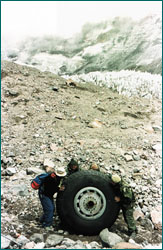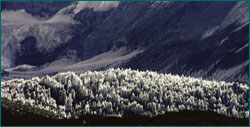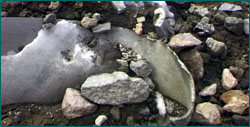 |
 |
|  Dave King
Dave King
|
Reading the Wreckage
If determining the cause of modern airplane crashes such as TWA 800 or EgyptAir
990 poses daunting challenges for air-crash experts, imagine trying to glean
the reasons why a plane went down over half a century ago. Stardust, the
civilian Lancastrian aircraft whose mysterious loss is chronicled in the NOVA
program "Vanished!", disappeared in August 1947 while flying from Buenos Aires,
Argentina to Santiago, Chile. Stardust and its 11 passengers and crew
remained lost until January 2000, when a glacier high in the Andes began
coughing up its wreckage and human remains. Here, David F. King, a Principal
Inspector at England's Air Accidents Investigation Branch in Farnborough,
Hampshire, and an air-crash expert for the past 30 years, gives us an idea of
what investigators are up against.
NOVA: When you arrive at a crash site, what are you first trying to do?
KING: One of the first concerns is to preserve the scene. Once rescue or
fire-fighting is complete, we want to make sure activity stops that might
damage the scene from the point of view of residual evidence. Then we begin to
collect that initial evidence and try to understand the primary parameters for
the impact. What was the nature of the arrival of the aircraft at the scene?
Was the aircraft in substantially level and probably controlled flight? Or was
it descending vertically and out of control? So we're looking at the impact
marks, the damage to the aircraft, and so on, to try and make those initial
assessments. A sense of how the aircraft arrived offers us the chance to
project the aircraft back into the sky, if you like, to the point just before
the impact, so we have a feel for its arrival at the scene of the
accident.
NOVA: How important is it to arrive at the site as soon as possible after the
accident?
KING: We like to arrive as early as we possibly can because some of the
evidence is fragile by nature. We don't want vehicles to start running over the
very ground marks that might give us information about the sort of arrival that
the aircraft made at the scene.
 Argentine military officers recover one of Stardust's
wheels.
Argentine military officers recover one of Stardust's
wheels.
|
|
NOVA: What can the spread of the wreckage on the ground tell you about the kind
of catastrophe that might have befallen the plane?
KING: The spread of wreckage over the ground considered in the context of the
local terrain can tell us quite a lot about the arrival of the aircraft in
terms of the amount of energy and the nature of the flight immediately prior to
hitting the ground. If the aircraft has come down vertically with relatively
low energy, the wreckage will be contained in a relatively small area,
dependent on the size of the aircraft, of course. If the aircraft is flying
straight and level at high speed when it first touches the ground, then the
wreckage will distribute itself typically in a fan shape over quite a large
area. If the aircraft starts to break up in the air, particularly at
significant height, then it will start to distribute pieces that will travel
with the wind and be spread over sometimes many hundreds of square miles. If
you consider the Lockerbie event, which happened at 31,000 feet, then the
wreckage distributes itself over a large area of countryside.
NOVA: What are your thought processes when you're trying to work out what
happened?
KING: We want to understand in as much detail as we can what has
happened. From an understanding of what has happened the big question then is
how could that have happened, and ultimately why did it happen.
It's in solving the question as to why it happened that we get some insight
into preventing it from happening again. [For other accidents not fully
explained, see Mysterious Plane Crashes.]
NOVA: Which of those processes is most difficult?
KING: That's dependent on the particular accident. In some circumstances the
what is very easily understood, and the why is generally more
difficult. If you can't get to the what in the first place, however, the
why can be impossible to resolve.
|  Mount
Tupangato, the Andean mountain where Stardust crashed.
Mount
Tupangato, the Andean mountain where Stardust crashed.
|
NOVA: How do you go about mapping a debris field?
KING: When we map out the wreckage distribution at any scene it is, of course,
to give us the precise location of the aircraft components, again to evaluate
impact parameters. It varies how we would go about that in different terrain.
On a flat, open plain it's not too difficult to map where pieces are and come
to some conclusions about the impact fairly quickly. If you're in mountainous
or wooded terrain, it's very difficult from any one point on the ground to get
a good view of the wreckage distribution. In such cases you need to plot the
location of individual pieces and then construct a diagram or some form of
presentation to gain that critical vantage point.
NOVA: When you have worked out angle of impact, what does that lead you to
think?
KING: Establishing the angle of impact helps us to focus in particular areas
for the remainder of the investigation or at least the next phase. If the
aircraft hit the ground flying in nominally straight and level flight, then one
might be looking, for example, at navigation difficulties; one is less likely to
suspect a power problem if the aircraft was flying straight and level. If the
aircraft descended vertically and out of control, one might focus on the
control systems. Equally, if the aircraft has high energy at the time of
impact, it's less likely that there was a power problem. If the aircraft has
low energy and low speed, then we might well start to focus more on the
engines, the aircraft's source of power.
NOVA: What kind of things might lead an airplane to arrive nose-first into the
ground?
KING: Arriving nose-first the aircraft was basically out of control. It could
happen if the aircraft were to stall—that is, lose lift on the wings—and
pitch nose-down and be too close to the ground for the pilot to achieve a
recovery. An aircraft out of control for other reasons could crash into the
ground in a similar nose-down attitude but in an unstalled state. There one
would expect to see much higher energy, much more fragmentation, much more
ground penetration perhaps.
 Even heavy metal
parts such as Stardust's propellors sustained severe damage in the
crash.
Even heavy metal
parts such as Stardust's propellors sustained severe damage in the
crash.
|
|
NOVA: What causes a plane to stall?
KING: An aircraft can stall for a number of reasons. Too high a nose attitude
for a particular speed will cause the wing flow to separate and the aircraft to
stall. Other features can affect an aircraft's aerodynamics and precipitate a
stall. For instance, icing, an accumulation of ice on the airframe, can disturb
the airflow and create conditions for a stall.
NOVA: In what sort of conditions do you expect to find icing?
KING: Icing can occur when the temperature outside the aircraft is low enough,
and if the aircraft flies in moisture, clouds, or falling rain it can then
freeze on the aircraft's surfaces. This can be visible to the pilot if ice
starts to accumulate, for example, on the windscreen wipers, which are in his
range of view as he looks forward. There are certain drills to check for ice on
the airframe if it is threatened.
NOVA: What would you expect with really serious icing?
KING: Serious ice accumulation on aircraft has a number of direct effects: It
increases the weight of the aircraft. It affects performance by altering the
plane's streamlined shape. As the ice accumulates, it can increase drag
markedly, causing the aircraft to slow down. Enough ice on the wings can
disturb airflow over the wings to such an extent that the airflow breaks down
completely and the wings stall. Equally, ice on certain parts of the airframe
can affect the aircraft's controllability by greatly affecting the ability of
the flight-control surfaces to have their desired effect.
NOVA: Under what circumstances would a plane apparently under the control of
the pilot fly into the ground?
KING: When aircraft that are operating under control and are nominally
serviceable are flown into the ground, they are referred to as
controlled-flight-into-terrain accidents. CFIT accidents normally have a major
weather factor involved. Pilots obviously don't fly into ground that's visible,
easily seen. Clouds can obscure the surface; peculiar cloud formations across
mountainous terrain can deceive pilots as to what is ground and what is sky;
sometimes a snow-covered surface can actually appear as other than normal
terrain; nighttime offers a pilot fewer visual cues—things like
that.
Continue: What sort of wreckage pattern might you expect from a crash in
mountainous territory?
Solve the Mystery of STENDEC |
Mysterious Plane Crashes
Reading the Wreckage |
Inside the Jet Stream |
Resources
Transcript |
Site Map |
Vanished! Home
Editor's Picks |
Previous Sites |
Join Us/E-mail |
TV/Web Schedule
About NOVA |
Teachers |
Site Map |
Shop |
Jobs |
Search |
To print
PBS Online |
NOVA Online |
WGBH
© | Updated January 2001
|
|
|